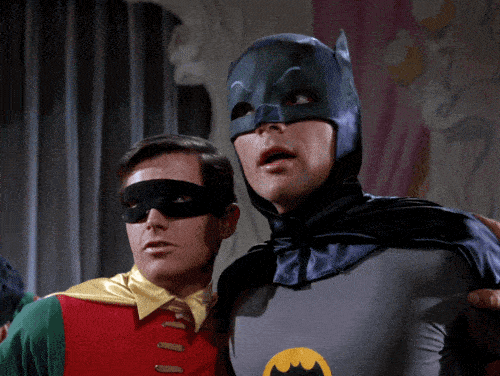FIVE-O YOUR ENTHUSIASM (12)
By:
May 10, 2021
One in a series of 25 enthusiastic posts, contributed by 25 HILOBROW friends and regulars, on the topic of our favorite TV shows of the Sixties (in our periodization: 1964–1973).

BATMAN | 1966–1968
The Batman story “The Secret of the Waiting Graves,” in Detective Comics #395 (Jan. 1970; the first issue written by Dennis O’Neil and drawn by Neal Adams), is a gothic horror fantasy signaling the comic-book character’s reversion to his original “grim avenger” aspect. This strategic shift — one which paved the way for Frank Miller’s antiheroic dark knight, with whom we are all too familiar now — was DC’s panicked over-correction to the live-action Batman TV show’s sensibility, which critics at the time described as “campy.”
Camp is anti-serious, or so the dominant culture would have us believe. The antidote, we’re told, is to play it “straight”: serious, even grim.
Addressing this topic in his 1973 collection Existential Errands, Norman Mailer would gripe that during the Sixties a frivolous camp sensibility had triumphed in US culture, replacing intense, fervent discussion of crucial issues with “gesture, role, costume, supposition, and borrowed manner.” Via his own impassioned writing about boxing, bullfighting, etc., Mailer crowed, he was even now generating a cultural atmosphere so “livid” that “Camp [would be] stripped of its marks of quotation, and put-ons shrivel.” Doesn’t the strutting, preening Mailer — whose 1960 essay “Superman Comes to the Supermart” had pleaded for a DC-ish “existential hero” to revitalize the insufficiently virile American character — sound like a Batman show villain detailing his nefarious scheme… immediately before getting socked in the kisser? POW!
As I’ve written elsewhere, what Mailer and other sobersided polemicists (and even Sontag) over the years have willfully failed to comprehend is that Camp is not anti-serious, but instead anti-earnest. Camp, like the embattled, ingenious, irrepressible queer subculture from which the subversive sensibility first emerged, appreciates and pays close attention to the phenomena that it mocks — far more so than do the ham-handedly earnest defenders of these same phenomena. Camp, to borrow a line from Adorno (who was talking about Freud’s cold detachment), “is nothing but an expression of … hopeless love which may be the only expression of hope still permitted to us.” The Batman show, and Adam West’s performance in particular, demands to be “read” as a self-consciously goofy cri de cœur.
It’s clear that the show’s creator, William Dozier, believed that the Batman franchise had since WWII become middlebrow-ized: earnest and upbeat, where once it had been bleak, fierce. Dozier criticized the Fifties-era Batman by having West issue PSA-style asides about the importance of wearing seat belts, say, or drinking milk. The show’s devotion to gesture, role, costume, supposition, and borrowed manner — West’s deadpan delivery of absurd dialogue is best described as Ionesco-esque — demands to be understood as an ironic expression of heartbroken love for the pre-middlebrow Batman.
Asked, in 1963, to define Pop Art, Andy Warhol explained, “It’s liking things.” In the tradition of one of the first Pop Art paintings, Look Mickey (1961), an ironic expression of Roy Lichtenstein’s heartbreak over the middlebrow-ization of Mickey Mouse, the Batman show is a highbrow ideologiekritik communicated via a fun lowbrow medium. ZAM!
FIVE-O YOUR ENTHUSIASM: INTRODUCTION by Josh Glenn | Lynn Peril on DARK SHADOWS (1966–1971) | Mark Kingwell on THE MAN FROM U.N.C.L.E. (1964–1968) | Elizabeth Foy Larsen on I DREAM OF JEANNIE (1965–1970) | Luc Sante on SECRET AGENT/DANGER MAN (1964–1968 seasons) | Erin M. Routson on THE PATTY DUKE SHOW (1963–1966 run) | Gordon Dahlquist on HAWAII FIVE-O (1968–1973 seasons) | Annie Nocenti on GET SMART (1965–1970) | Sara Driver on THE ADDAMS FAMILY (1964–1966) | Carlo Rotella on MANNIX (1967–1973 seasons) | Adam McGovern on JULIA (1968–1971) | Mimi Lipson on THE MARY TYLER MOORE SHOW (1970–1973 seasons) | Josh Glenn on BATMAN (1966–1968) | Tom Nealon on HOGAN’S HEROES (1965–1971) | Miranda Mellis on THE ODD COUPLE (1970–1973 seasons) | Peggy Nelson on GILLIGAN’S ISLAND (1964–1967) | Susan Roe on THE BRADY BUNCH (1969–1973 seasons) | Michael Grasso on UFO (1970–1973) | Richard McKenna on DOOMWATCH (1970–1972) | Adrienne Crew on BEWITCHED (1964–1972) | Michael Lewy on STAR TREK (1966–1969) | Greg Rowland on THE PARTRIDGE FAMILY (1970–1973 seasons) | David Smay on THE MONKEES (1966–1968) | Vijay Parthasarathy on THE DICK VAN DYKE SHOW (1964–1966 seasons) | Carl Wilson on THE CAROL BURNETT SHOW (1967–1973 seasons) | Jessamyn West on EMERGENCY! (1972–1973 seasons).
JACK KIRBY PANELS | CAPTAIN KIRK SCENES | OLD-SCHOOL HIP HOP | TYPEFACES | NEW WAVE | SQUADS | PUNK | NEO-NOIR MOVIES | COMICS | SCI-FI MOVIES | SIDEKICKS | CARTOONS | TV DEATHS | COUNTRY | PROTO-PUNK | METAL | & more enthusiasms!
